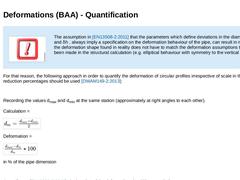
|
Important: The assumption in [EN13508-2:2011] that the parameters which define deviations in the diameter, δv and δh , always imply a specification on the deformation behaviour of the pipe, can result in mistakes, as the deformation shape found in reality does not have to match the deformation assumptions that have been made in the structural calculation (e.g. elliptical behaviour with symmetry to the vertical axis) For that reason, the following … |
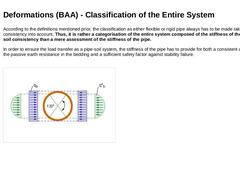
|
According to the definitions mentioned prior, the classification as either flexible or rigid pipe always has to be made taking the soil consistency into account. Thus, it is rather a categorisation of the entire system composed of the stiffness of the pipe and soil consistency than a mere assessment of the stiffness of the pipe. In order to ensure the load transfer as a pipe-soil system, the stiffness of the pipe has to provide for both a consistent … |
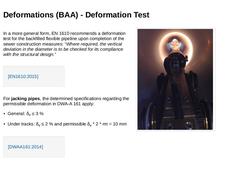
|
In a more general form, EN 1610 recommends a deformation test for the backfilled flexible pipeline upon completion of the sewer construction measures: “Where required, the vertical deviation in the diameter is to be checked for its compliance with the structural design.” For jacking pipes, the determined specifications regarding the permissible deformation in DWA-A 161 apply: |
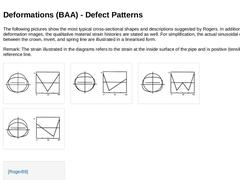
|
The following pictures show the most typical cross-sectional shapes and descriptions suggested by Rogers. In addition to the deformation images, the qualitative material strain histories are stated as well. For simplification, the actual sinusoidal courses between the crown, invert, and spring line are illustrated in a linearised form. Remark: The strain illustrated in the diagrams refers to the strain at the inside surface of the pipe and is positive (… |
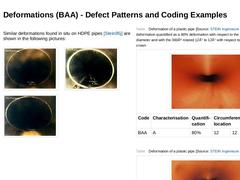
|
Similar deformations found in situ on HDPE pipes [Stein95j] are shown in the following pictures: (Image: Deformation figure of a HDPE pipe [Stein95j]) (Image: Deformation figure of a HDPE pipe [Stein95j]) (Image: Deformation figure of a HD-PE pipe [Stein95j]) (Table: Deformation of a plastic pipe)
(Table: Deformation of a plastic pipe )
|
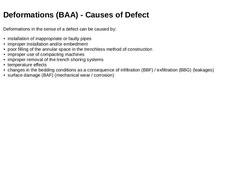
|
Deformations in the sense of a defect can be caused by: -
installation of inappropriate or faulty pipes
-
improper installation and/or embedment
-
poor filling of the annular space in the trenchless method of construction
-
improper use of compacting machines
-
improper removal of the trench shoring systems
-
temperature effects
-
changes in the bedding conditions as a consequence of infiltration (BBF) / exfiltration (BBG) (leakages)
-
surface damage (BAF) (…
|
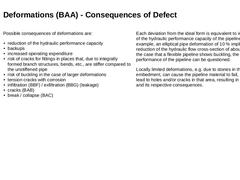
|
Possible consequences of deformations are: -
reduction of the hydraulic performance capacity
-
backups
-
increased operating expenditure
-
risk of cracks for fittings in places that, due to integrally formed branch structures, bends, etc., are stiffer compared to the unstiffened pipe
-
risk of buckling in the case of larger deformations
-
tension cracks with corrosion
-
infiltration (BBF) / exfiltration (BBG) (leakage)
-
cracks (BAB)
-
break / collapse (BAC)
|
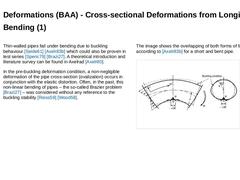
|
Thin-walled pipes fail under bending due to buckling behaviour [Seide61] [Axelr83b] which could also be proven in test series [Spenc79] [Brazi27]. A theoretical introduction and literature survey can be found in Axelrad [Axelr80]. In the pre-buckling deformation condition, a non-negligible deformation of the pipe cross-section (ovalization) occurs in conjunction with the elastic distortion. Often, in the past, this non-linear bending of pipes – the … |
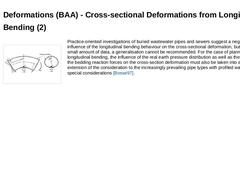
|
(Image: Cylindrical shell under critical bending load to [Axelr83b]) Practice-oriented investigations of buried wastewater pipes and sewers suggest a negligible influence of the longitudinal bending behaviour on the cross-sectional deformation, but due to the small amount of data, a generalisation cannot be recommended. For the case of planned longitudinal bending, the influence of the real earth pressure distribution as well as the influence of the … |
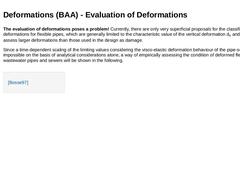
|
The evaluation of deformations poses a problem! Currently, there are only very superficial proposals for the classification of deformations for flexible pipes, which are generally limited to the characteristic value of the vertical deformation dv and generally assess larger deformations than those used in the design as damage. Since a time-dependent scaling of the limiting values considering the visco-elastic deformation behaviour of the pipe-soil-… |
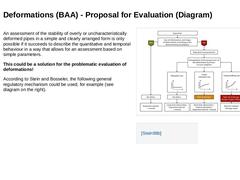
|
An assessment of the stability of overly or uncharacteristically deformed pipes in a simple and clearly arranged form is only possible if it succeeds to describe the quantitative and temporal behaviour in a way that allows for an assessment based on simple parameters. This could be a solution for the problematic evaluation of deformations! According to Stein and Bosseler, the following general regulatory mechanism could be used, for example (see diagram … |
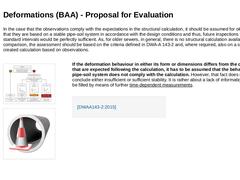
|
In the case that the observations comply with the expectations in the structural calculation, it should be assumed for older sewers that they are based on a stable pipe-soil system in accordance with the design conditions and thus, future inspections within the standard intervals would be perfectly sufficient. As, for older sewers, in general, there is no structural calculation available for a comparison, the assessment should be based on the criteria … |
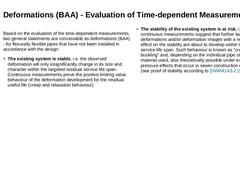
|
Based on the evaluation of the time-dependent measurements, two general statements are conceivable as deformations (BAA) - for flexurally flexible pipes that have not been installed in accordance with the design: -
The existing system is stable, i.e. the observed deformation will only insignificantly change in its size and character within the targeted residual service life span. Continuous measurements prove the positive limiting value behaviour of …
|
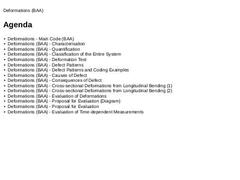
|
|
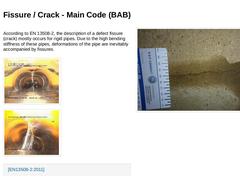
|
According to EN 13508-2, the description of a defect fissure (crack) mostly occurs for rigid pipes. Due to the high bending stiffness of these pipes, deformations of the pipe are inevitably accompanied by fissures. (Image: Fissure (BAB) in a PVC plastic pipe - longitudinal crack with groundwater infiltration and deformation) (Image: Fissure (BAB) in a PVC plastic pipe - longitudinal crack with groundwater infiltration and deformation 2) |
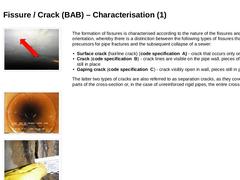
|
(Image: Crack in concrete in a large profile)
(Image: Cracks in vitrified clay pipes - spalling at the cracks, shadows at the crack edges are recognisable )
(Image: Crack measurement in the course of condition assessment) The formation of fissures is characterised according to the nature of the fissures and their orientation, whereby there is a distinction between the following types of fissures that can be the precursors for pipe fractures and the … |
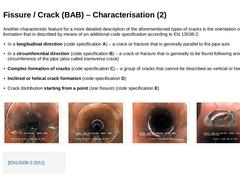
|
Another characteristic feature for a more detailed description of the aforementioned types of cracks is the orientation of the crack formation that is described by means of an additional code specification according to EN 13508-2: -
In a longitudinal direction (code specification A) – a crack or fracture that is generally parallel to the pipe axis
-
In a circumferential direction (code specification B) – a crack or fracture that is generally to be found …
|
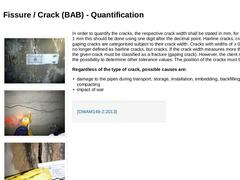
|
(Image: Crack examination - measurement 2) (Image: Crack in the concrete in a large profile ) (Image: Crack measurement in the course of condition assessment) In order to quantify the cracks, the respective crack width shall be stated in mm, for values under 1 mm this should be done using one digit after the decimal point. Hairline cracks, cracks, and gaping cracks are categorised subject to their crack width. Cracks with widths of ≥ 0.5 mm are no longer … |
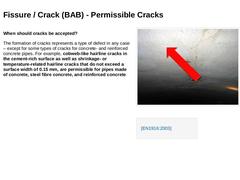
|
When should cracks be accepted? The formation of cracks represents a type of defect in any case – except for some types of cracks for concrete- and reinforced concrete pipes. For example, cobweb-like hairline cracks in the cement-rich surface as well as shrinkage- or temperature-related hairline cracks that do not exceed a surface width of 0.15 mm, are permissible for pipes made of concrete, steel fibre concrete, and reinforced concrete. |
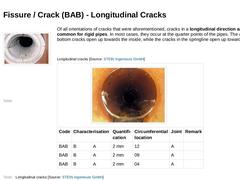
|
(Image: Four joint ring crack) Of all orientations of cracks that were aforementioned, cracks in a longitudinal direction are most common for rigid pipes. In most cases, they occur at the quarter points of the pipes. The crown- and bottom cracks open up towards the inside, while the cracks in the springline open up towards the outside. (Table: Longitudinal cracks) (Table: Longitudinal cracks) (Table: Longitudinal cracks in a large profile – Gaping cracks … |
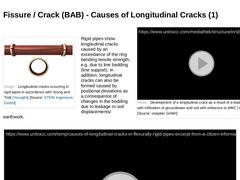
|
(Image: Longitudinal cracks occurring in rigid pipes in accordance with Young and Trott)
Rigid pipes show longitudinal cracks caused by an exceedance of the ring bending tensile strength, e.g. due to line bedding (line support). In addition, longitudinal cracks can also be formed caused by positional deviations as a consequence of changes in the bedding due to leakage or soil displacements/earthwork. (Video: Development of a longitudinal crack as … |
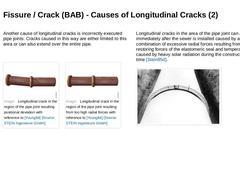
|
Another cause of longitudinal cracks is incorrectly executed pipe joints. Cracks caused in this way are either limited to this area or can also extend over the entire pipe. (Image: Longitudinal crack in the region of the pipe joint resulting positional deviation with reference to [Young84] [Image: S&P GmbH]) (Image: Longitudinal crack in the region of the pipe joint resulting from too high radial forces with reference to [Young84] [Image: S&P GmbH]) |
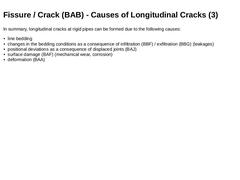
|
In summary, longitudinal cracks at rigid pipes can be formed due to the following causes: -
line bedding
-
changes in the bedding conditions as a consequence of infiltration (BBF) / exfiltration (BBG) (leakages)
-
positional deviations as a consequence of displaced joints (BAJ)
-
surface damage (BAF) (mechanical wear, corrosion)
-
deformation (BAA)
|
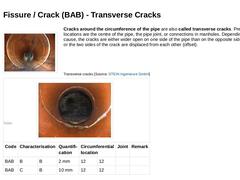
|
(Image: Transverse crack in a vitrified clay sewer)Cracks around the circumference of the pipe are also called transverse cracks. Predestined locations are the centre of the pipe, the pipe joint, or connections in manholes. Depending on the cause, the cracks are either wider open on one side of the pipe than on the opposite side (angulation), or the two sides of the crack are displaced from each other (offset). (Table: Transverse cracks ) |
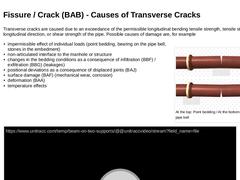
|
Transverse cracks are caused due to an exceedance of the permissible longitudinal bending tensile strength, tensile stresses in a longitudinal direction, or shear strength of the pipe. Possible causes of damage are, for example (Image: Formation of vertical cracks due to wrong bedding of the pipe in accordance with Brennan and Young) -
impermissible effect of individual loads (point bedding, bearing on the pipe bell, stones in the embedment)
-
non-articulated …
|